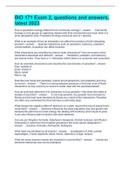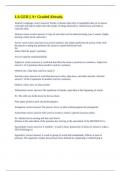Chapter 1: Comparable
Companies Analysis questions
with verified solutions 2024-2025
Comparable Company Analysis provides a _________ against which a
banker can establish valuation for a private company or analyze the
value of a public company at a given point in time. - answer
benchmark
The foundation for trading comps is built upon the premise that
similar companies provide a highly relevant ________ ________ for
valuing a given target, due to the fact that they share _______
__________ and _________ _____________, ________ __________, and ________. -
answer reference point, key business and financial characteristics,
performance drivers, and risks.
The core of Comparable Company Analysis involves selecting a
__________ of comparable companies for the target. These peer
companies are benchmarked against one another and the target
based on various _______ ________ and ________. ________ _______ are then
calculated for the universe, which serve as a basis for __________ a
valuation range for the target. - answer universe. financial statistics
and ratios. Trading multiples, extrapolating
While P/E is the most broadly recognized in circles outside Wall
Street, multiples based on enterprise value are widely used by
bankers because they are independent of ________ ________ and other
factors unrelated to business operations, such as ______ ______ and
_________ ________. - answer capital structure, tax regimes and
accounting policies
Comparable Company Analysis is designed to reflect "_________"
valuation, based on prevailing _________ ________ and ________. As such,
,in many cases it is more relevant than intrinsic valuation analysis,
such as DCF. At the same time, market trading levels may be subject
to periods of _________ investor sentiment that skew valuation either
too high or low. - answer "current", market conditions and
sentiment. irrational
Comparable Company Analysis Steps: - answer 1. Select the
universe of comparable companies
2. Locate the necessary financial information
3. "Spread" key statistics, ratios, and trading multiples
4. Benchmark the comparable companies
5. Determine Valuation
Comparable Company Analysis Step 1: Select the Universe of
Comparable Companies
For a target with no clear, publicly traded comparable, the banker
seeks companies outside the target's ______ _______, that share
________ and ________ _________ on some fundamental level. - answer
core sector, business and financial characteristics.
Comparable Company Analysis Step 1: Select the Universe of
Comparable Companies
Companies that share core business characteristics tend to serve as
good comparables. These core traits include: - answer sector,
products and services, customers and end markets, distribution
channels, and geography
Comparable Company Analysis Step 1: Select the Universe of
Comparable Companies
,Key financial characteristics must also be examined both as a means
of understanding the target and identifying the best comparable
companies. These core traits include: - answer size, profitability,
growth profile, return on investment, and credit profile
Comparable Company Analysis Step 1: Select the Universe of
Comparable Companies
Size is typically measured in terms of ________ ________ (equity value
and enterprise value), as well as key financial statistics (sales, gross
profit, EBITDA, EBIT, and net income). - answer market valuation
Comparable Company Analysis Step 1: Select the Universe of
Comparable Companies
A company's profitability measures its ability to ________ sales into
profit. Profitability ratios employ a measure of ________ in the
numerator, such as _____ ______, _________, ________, or _____ ______, and
_________ in the denominator.
As a general rule, for companies in the same sector, higher profit
margins translate into _________ valuations, all else being equal. -
answer convert. profit, gross profit, EBITDA, EBIT, or net income,
and sales
higher
Comparable Company Analysis Step 1: Select the Universe of
Comparable Companies
A company's growth profile, as determined by its historical and
estimated future financial performance, is a critical driver of
valuation. Equity investors reward high growth companies with
_________ trading multiples than slower growing peers. They also
, discern whether the growth is primarily _________ or __________-driven,
with the former generally viewed as preferable.
For mature public companies, _______ growth rates are typically more
meaningful. For early stage or emerging companies with little or no
earnings, however, ________ or _________ growth trends may be more
relevant. - answer higher. organic or acquisition-driven
EPS. sales or EBITDA
Comparable Company Analysis Step 1: Select the Universe of
Comparable Companies
Return on Investment (ROI) measures a company's ability to provide
earnings (or returns) to its capital providers. ROI ratios employ a
measure of ____________ (EBIT, NOPAT, or net income) in the __________,
and a measure of ____________ (invested capital, shareholders' equity,
or total assets) in the __________.
The most commonly used ROI metrics are _______ ____ _________ _______
(ROIC), _______ , and _______. ________ ________ is another type of return
metric. - answer profitability in the numerator, capital in the
denominator.
return on invested capital, ROE, and ROA. Dividend yield
Comparable Company Analysis Step 1: Select the Universe of
Comparable Companies
A company's credit profile refers to its creditworthiness as a
borrower. It is typically measured by metrics relating to a company's
overall debt level (__________), as well as its ability to make interest
payments (________), and reflects key company and sector-specific
benefits and risks. - answer leverage, coverage






